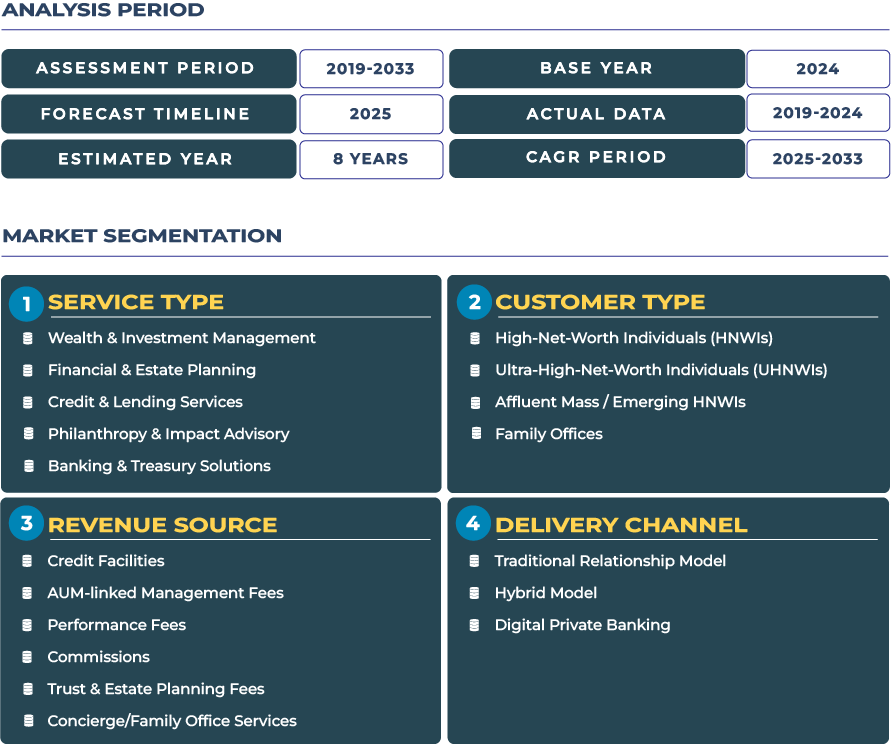Market Outlook: Unlocking Growth Pathways for Asia Pacific’s Private Banking Landscape Through 2033
The market outlook for Asia Pacific private banking signals strategic depth and diversified growth rather than uniform exuberance. Transitioning from USD 365.3 billion in 2025 to USD 572.2 billion by 2033 at a CAGR of ~5.8%, the region illustrates how wealth‐creation is driving demand for more sophisticated private banking services. The markets in this region are not only expanding in volume but evolving in complexity-with clients demanding integrated wealth & investment management, estate & legacy planning, tailored credit & lending services, impact advisory and banking & treasury solutions.
Note:* The market size refers to the total revenue generated by banks through various services.
This growth is supported by both supply-side and demand-side shifts: increasing entrepreneurial wealth generation, rising family-office activity, and accelerating fintech adoption across Asia. At the same time, the expansion is not without friction-regulatory fragmentation across jurisdictions, geopolitical tensions and the ongoing digital arms-race among banks raise cost and complexity. The path to capture the 5.8% CAGR will require private banking firms to invest in digital platforms, deliver pan-Asian advisory capability and build seamless multi-jurisdictional client solutions.
Growth Catalysts & Structural Constraints: Key Drivers and Barriers in the Asia Pacific Private Banking Sector
Several factors underpin growth in the Asia Pacific private banking market. First, the explosive increase in HNWI populations across India, China and Southeast Asia creates a large base of affluent individuals requiring advanced wealth management. Second, family‐office evolution in Asia is accelerating-many wealthy families are institutionalising their wealth, thereby creating demand for full-service private banking platforms. Third, the region’s technology readiness is higher than many legacy markets: digital onboarding, advisory apps and embedded payments/treasury are increasingly standard, enabling private banks to scale services and lower cost-to-serve.
Nevertheless, the market faces significant headwinds. Regulatory fragmentation-differing rules across China, India, Singapore, Australia and ASEAN markets-raises compliance and operational burden. Wealth concentration remains uneven: while the number of affluent individuals is rising, the ultra-HNW segment is still less mature compared to Switzerland or the U.S., limiting fee base for some firms. Talent shortages in wealth-advisory roles, cultural diversity across markets and competition from fintech challengers add further complexity. These factors moderate overall growth and highlight the importance of differentiated service models for private banking players in Asia Pacific.
Trend-Vectors & Opportunity Frameworks: AI-Driven Advisory, Digital Family Offices and Cross-Border Wealth Hubs in Asia Pacific Private Banking
The Asia Pacific private banking market is witnessing several important trends. Among them, AI-driven advisory platforms are becoming mainstream: mobile clients expect data-driven investment insights, portfolio diagnostics and integrated treasury/credit flows. Digital family offices are expanding: given the region’s rising intergenerational wealth transfers, families are seeking multi-asset, multi-jurisdictional platforms rather than standalone private banking. Sustainable investing is also ascending in Asia, with affluent clients requesting ESG-integrated portfolios and philanthropic advisory.
Private banks in Asia Pacific can capture growth by focusing on regional wealth hubs such as Singapore, Hong Kong, and Dubai, which serve as gateways for Asia, along with emerging hubs in Southeast Asia. They should also expand cross-border family-office services to support families with assets across multiple jurisdictions through integrated credit, estate, and treasury solutions. Additionally, fintech-driven growth can be achieved through alliances with digital-wealth platforms, robo-advisors, tokenised asset access, and embedded banking and treasury capabilities. Firms that execute on these opportunity frameworks are best positioned to benefit from the projected market growth and evolving client expectations in the region.
Competitive Landscape: Strategic Realignment and Network-Orchestration in Asia Pacific Private Banking
The competitive dynamics in Asia Pacific’s private banking market are evolving rapidly. One leading institution, HSBC Private Bank, has announced the appointment of a regional head of investment counsellors for Asia Pacific, reinforcing the bank’s commitment to the region. Key strategic themes across the sector include building pan-Asia wealth networks that align local expertise with global product platforms, integrating open-banking and wealth-technology stacks to deliver seamless advisory, credit, treasury, and payment flows, and forming fintech partnerships to accelerate digital onboarding, alternative-asset access, and advisory scalability. As competition intensifies, private banks that transition from discrete product silos to orchestrated wealth-service ecosystems will achieve stronger differentiation in the region.








